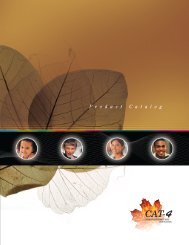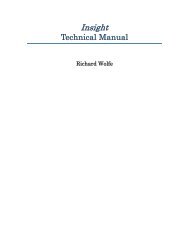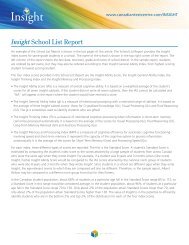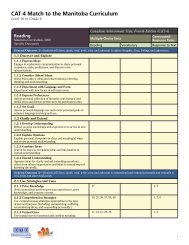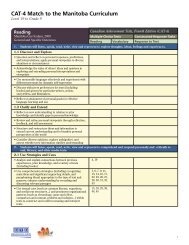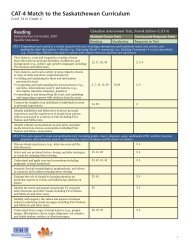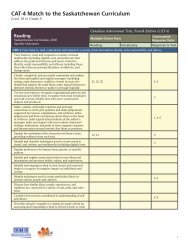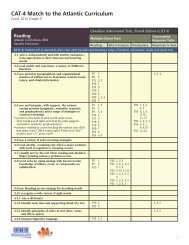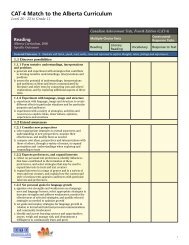Grade 10 - Canadian Test Centre
Grade 10 - Canadian Test Centre
Grade 10 - Canadian Test Centre
You also want an ePaper? Increase the reach of your titles
YUMPU automatically turns print PDFs into web optimized ePapers that Google loves.
CAT∙4 Match to the Alberta Curriculum<br />
Level 20 - 22 to <strong>Grade</strong> <strong>10</strong><br />
Reading<br />
Alberta Curriculum, 2000<br />
Specific Outcomes<br />
<strong>Canadian</strong> Achievement <strong>Test</strong>s, Fourth Edition (CAT·4)<br />
Multiple-Choice <strong>Test</strong>s<br />
Reading<br />
Literary<br />
Reading<br />
Vocabulary<br />
Constructed-<br />
Response Tasks<br />
Response to Text<br />
General Outcome 2 - Students will listen, speak, read, write, view and represent to comprehend literature and other texts in oral, print,<br />
visual and multimedia forms, and respond personally, critically and creatively.<br />
2.1 Construct meaning from text and context<br />
2.1.1 Discern and analyze context<br />
a. identify a variety of different kinds of texts, audiences and<br />
purposes for creating texts<br />
b. use features found within a text as information to<br />
describe the communication situation within which the<br />
text was created<br />
c. describe the relationship between text and context<br />
d. identify the impact that personal context—experience,<br />
prior knowledge—has on constructing meaning from a<br />
text<br />
2.1.2 Understand and interpret content<br />
a. use a variety of strategies to comprehend literature and<br />
other texts and develop strategies for close reading of<br />
literature in order to understand contextual elements<br />
b. paraphrase a text’s controlling idea, and identify<br />
supporting ideas and supporting details<br />
c. summarize the plot of a narrative, describe its setting<br />
and atmosphere, describe development of conflict, and<br />
identify theme<br />
d. describe the personality traits, motivations, attitudes,<br />
values and relationships of characters developed/persons<br />
presented in literature and other texts; and identify how<br />
the use of archetypes adds to an appreciation of text<br />
e. describe a text creator’s tone, and relate tone to purpose<br />
and audience<br />
f. differentiate between literal and figurative statements<br />
and between imagery and nonsensory language, identify<br />
symbol, recognize familiar allusions, and describe how<br />
images are developed in texts<br />
g. describe visual elements and aural elements, and<br />
describe their contributions to the meaning of texts<br />
h. differentiate between audience response to the content of<br />
a presentation and audience response to the performance<br />
of the presenter<br />
20<br />
1, 2, 4, 6, 7, 9,<br />
11, 13, 16, 25,<br />
26, 28, 33, 36,<br />
38<br />
2, 4, 6, 9, 13,<br />
14, 15, 18, 19,<br />
20, 26, 27, 29,<br />
31, 32, 33, 35,<br />
36, 37, 39<br />
14, 15, 16, 17,<br />
18, 19, 20, 21,<br />
22, 23, 24, 25,<br />
26, 27, 28, 29,<br />
30<br />
2



